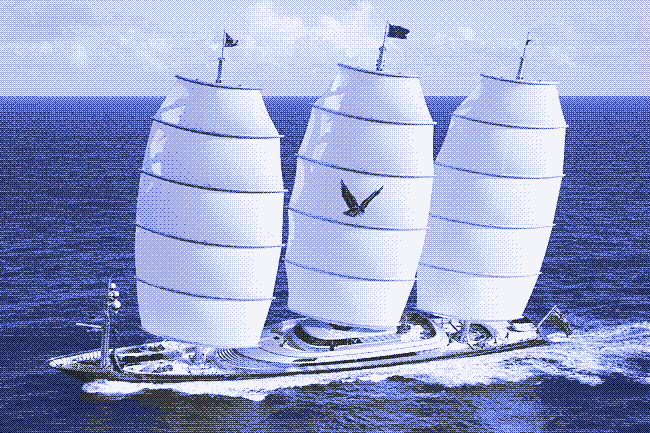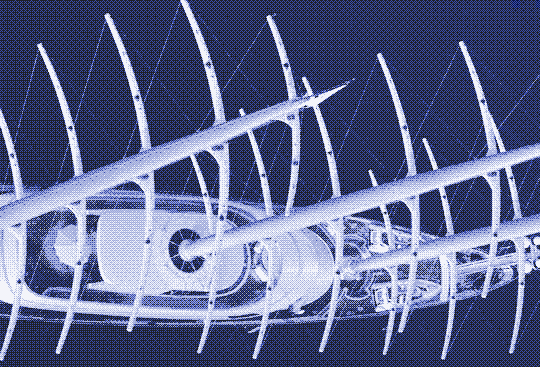
Lloyd Alter at Treehugger talks about our article on cargo ships and wonders if it is time for a new age of sail. One reader comments that sailing boats require a much larger crew than today’s cargo vessels, which would make a comeback of wind power unrealistic. Maybe, but these days, sailing boats can also be controlled by computers instead of sailors.
The need for a large crew to operate the rigs makes sailing ships not only expensive to operate, it also means that a significant part of the cargo space is taken up by cabins, provisions and water supplies. Sailings boats did better than rowing boats (which had a very limited range because of their even larger crew) but they were no competition for later steamboats and today’s diesel ships, which can get along with only a handful of sailors.
Automated sail handling
The 1902 Preussen (pictured here yesterday) was the first ship to automate sail handling. It had no auxiliary engines for propulsion, but it made use of steam power for the operation of the winches, hoists and pumps. This limited the crew to 48 men. By comparison: the Kruzenshtern a very large sailing vessel without mechanised control, has a crew of 257 men.
The Preussen had 5 masts (with a maximum height of 68 meters) and 47 sails (with a total surface area of 5,560 square meters or 60,000 square feet). It had a length of 147 meters (438 ft.) and a load-carrying capacity of 8,000 tons.
Today, sailing boats can be operated with even smaller crews. The Royal Clipper, a steel-hulled five masted cruise ship built in 2000 and inspired by the Pruessen (it is only slightly smaller), can be handled with a crew as small as 20, using powered controls. The Royal Clipper is the largest sailing ship in service today (although it does have auxiliary engines).
In 2006, automated control was taken to the extreme with the Maltese Falcon, the yacht of Silicon Valley venture capitalist Tom Perkins. The 88 meter (290 foot) long luxury yacht can be operated by one person using a central control unit. A small crew is required for maintenance and fixing problems, but nobody needs to be in the rig during sailing.
Touch of a button
Handling, hoisting and lowering of the sails is done at the touch of a button - the sails roll into the mast. The Maltese Falcon has 3 masts (58 meters high) and a total sail area of 2,400 square meters (almost 26,000 square feet). It is about half the size of the Preussen.

The Maltese Falcon is equipped with the DynaRig technology, a concept that was developed in Germany by W. Prolls in the 1960s as a propulsion alternative for commercial ships in the face of a looming energy crisis. It was never applied then - the Maltese Falcon is the first proof-of-concept. Now some smaller versions have been designed, too.
High-tech materials
The DynaRig is a high-tech version of a “square-rigger”, the kind of sail used by the Preussen. The main difference is that the yards (the horizontal spars) do not swing around a fixed mast but are attached permanently to a rotating mast. Only recent developments in high-tech materials such as carbon fibre have permitted this technology. The yards keep the sail in a fixed, wing-like form.

Contrary to a traditional sailboat, the rig of the Maltese Falcon scarcely shows any ropes or wires. But it does have dozens of computers and microprocessors, connected by 131,000 feet of cable. The Preussen is low-tech, the Maltese Falcon is high-tech.
Making money
The Maltese Falcon is a sumptuous yacht that is hard to qualify as environmentally friendly. Still, it demonstrates the effectiveness of powering very large boats with a modern sail, capable of being handled by the small crew necessary for a commercial cargo ship to have a chance of being profitable.
I prefer the low-tech way; higher taxes on fuel, lower taxes on labour. But if you want a revival of sail the high-tech way, you can have it.
Reactions
To make a comment, please send an e-mail to solar (at) lowtechmagazine (dot) com. Your e-mail address is not used for other purposes, and will be deleted after the comment is published. If you don’t want your real name to be published, sign the e-mail with the name you want to appear.
Reactions
Klaus
Cool, you corrected the misspelling, thanks! You even did this on the link.
Mind you, you *did* misspell your answer - it should be “Vielen Dank” :-D
PS: I lived on a sailing ship for 5 years. A ship leaning to one side is not particularly dangerous for its cargo - you can tie it down. Sails are also both easier to handle and assist in keeping the ship steady; it doesn’t roll as much which, I’m sure, is also safer for the cargo.
kdd
More comments at Slashdot:
http://tech.slashdot.org/article.pl?sid=09/04/14/1319203
Lighthouse
“I prefer the low-tech way; higher taxes on fuel, lower taxes on labour.”
Gee, if we’ve reached peak oil already, one would think that market forces would be enough to encourage alternate methods. Only a fool welcomes the taxation that takes wealth out of the economy where it can be employed to create even greater wealth.
Djima Habre
Large sails take away too much space.
They make the ship to lean on one side, which is too dangerous for the cargo.
Kites are a much better alternative, since they can capture a much stronger wind and do not need any space or a mast.
Anyway compact sails could be used for assistance.
Mehul Kamdar
There is a possibility of using sailships to ship valuable cargo - designer clothing, perfumes, beverages etc - instead of loading these into containers and making a profit without worrying about the politically suicidal steps that raising taxes on fuel would be. And in an age where carbon credits can be sold, sailship companies could use these as an additional way of bolstering their bottomlines.
I wonder how fast a modern tea clipper couls go and what tonnage of cargo it could carry with modern materials and controls of the kind used on the modern sailships listed here? Perhaps, this is a design challenge that a talented yacht designer needs to look at.
Cabrinha kiteboards
Awesome stuff, thanks a million times for sharing these pictures, you have really made my day my friend!
Chris
Captain Blight
There’s more to moving cargo than simply pressing a button. A ship needs a certain minimum number of crew simply for safe operation in fair weather; and what happens when things start going badly? I mean, try securing a load of treetrunks or pipes that have broken loose in a Force 8 gale and 10-meter seas with only the relief mate and the cook to do it. it’s not going to happen.
I’m not set against the idea but I also believe that Djima Habre has the right of it in Comment 4. Kites are *far* superior to mast-sails in every way. There’s a beneficient curve to their design spiral: Since the kites don’t need a mast as such, the hulls don’t need to be engineered to support the masts and the loads and stresses they impose. No masts means no shrouds or stays, no yards means no tacks and sheets and halyards, and that all means lower windage and ultimately a safer vessel. Since you could arrange things so the pull from the kite can come right at the waterline on the leeward side, there’s no heeling moment. You could sail on an even keel at all times.
The *only* disadvantage kites have is they don’t work to windward terribly well; but this is changing as the recreational market drives the engineering.
Kites, folks; kites.
Erasmus
Kruzenshtern is a school ship, hence large crew. Thus your comparison of crew sizes becomes meaningless.
Seba
Slow transport by sail is probably OK for non-perishable cargo, but I am not sure you will find today a crew eager to spend a few weeks on board. Perhaps unmanned sail ships (fully automatized and GPS-tracked) could be a possibility.
Vincent Treanor III
Ailing ships are practical and can make money. Studies in 1980 demonstrated that a ship similar to but larger than Preussen could be operated with automated sail systems and carry bulk, break bulk, liquid or containerized cargo at less cost than a comparable full powered ship with a schedule of only 2 to 5 days longer. The Kruzenshtern is a training ship, has been outfitted with an engine and is used as part of the Russian navy training program. No sailing vessel had a crew of more than 45 men or so. The crew did not sleep in cabins as such, they hot bunked in the Forecastle. Al living quarters were above the main deck and too no cargo space. They were fast - the P Liners ran liner schedules from Germany to ports in Peru.
Peter
What is low tech about using computers to control sails?
Another system has been developed which can control sails perfectly without computers, - that is truly low tech. It’s here: http://www.windthrusters.com
Jillian
I like this idea of a return to sail. I have just discovered this website. Is there an update since the article was written?